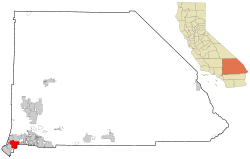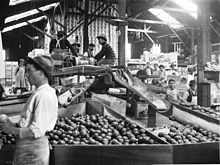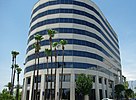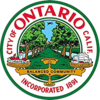
A | B | C | D | E | F | G | H | CH | I | J | K | L | M | N | O | P | Q | R | S | T | U | V | W | X | Y | Z | 0 | 1 | 2 | 3 | 4 | 5 | 6 | 7 | 8 | 9
This article needs additional citations for verification. (November 2022) |
Ontario, California | |
|---|---|
|
Clockwise: Ovitt Family Community Library; Empire Towers; Ontario Convention Center; Chaffey High School | |
| Motto: Southern California's Next Urban Center[1] | |
 Location in San Bernardino County in California | |
| Coordinates: 34°03′10″N 117°37′40″W / 34.05278°N 117.62778°W | |
| Country | United States |
| State | California |
| County | San Bernardino |
| Incorporated | December 10, 1891[2] |
| Named for | Ontario, Canada |
| Government | |
| • Type | City Council / City Manager[1] |
| • City Council[3] | Mayor Paul S. Leon Mayor Pro Tem Debra Dorst-Porada Alan D. Wapner Jim W. Bowman Ruben Valencia |
| Area | |
| • Total | 50.00 sq mi (129.50 km2) |
| • Land | 49.97 sq mi (129.43 km2) |
| • Water | 0.03 sq mi (0.08 km2) 0.13% |
| Elevation | 1,004 ft (306 m) |
| Population | |
| • Total | 175,265 |
| • Rank | 3rd in San Bernardino County 26th in California 149th in the United States |
| • Density | 3,507/sq mi (1,354.1/km2) |
| Time zone | UTC−8 (Pacific) |
| • Summer (DST) | UTC−7 (PDT) |
| ZIP codes | 91758, 91761, 91762, 91764 |
| Area code | 909 |
| FIPS code | 06-53896 |
| GNIS feature IDs | 1652764, 2411323 |
| Website | www |
Ontario is a city in southwestern San Bernardino County in the U.S. state of California, 35 miles (56 km) east of downtown Los Angeles and 23 miles (37 km) west of downtown San Bernardino, the county seat. Located in the western part of the Inland Empire metropolitan area, it lies just east of Los Angeles County and is part of the Greater Los Angeles Area. As of the 2020 Census, the city had a population of 175,265.[7]
The city is home to the Ontario International Airport, which is the 15th-busiest airport in the United States by cargo carried. Ontario handles the mass of freight traffic between the ports of Los Angeles and Long Beach and the rest of the country.[8]
It takes its name from the Ontario Model Colony development established in 1882 by the Canadian engineer George Chaffey and his brothers William Chaffey and Charles Chaffey.[9] They named the settlement after their home province of Ontario.
History
Tovaangar (-1771)
Ontario was inhabited by the Tongva people for over 1000 years.[10] Their country is now known as Tovaangar. The Ontario area was connected to the village of Cucamonga, whose location is not now precisely known.
The Spanish Empire's New Spain Portolá expedition found and named the Santa Ana River in 1769.[citation needed] They also explored the Cucamonga area.[11]
Spanish Empire (1771-1822)
In 1771, Franciscans from New Spain settled nearby, and established the Mission San Gabriel Arcángel, founding what is today San Gabriel.[12] They enslaved the Tongva people.[13] The area was now part of the New Spain Province of Las Californias.

Juan Bautista de Anza is said to have passed through the area on his 1774 expedition, which created a land route between the province of Sonora and San Gabriel.[14] An Ontario city park[14] and a middle school[15] now bear his name. The route became known as the El Camino Real.
In 1804, the northern part of Las Californias became the new province of Nueva California.[16]
In 1810, the San Gabriel Franciscans took over the Tongva village of Kaawchama (in today's west Redlands), replacing it with the Guachama rancheria. This included a chapel devoted to San Bernardino (beginning the association of the saint with the area). The rancheria was destroyed by the Serrano in 1812, and was rebuilt nearby as the San Bernardino de Sena estancia in 1819.
Mexico (1822-1847)
In 1822, word of the Mexican triumph in the Mexican War of Independence reached Nueva California,[17] and the lands previously controlled by the Spanish Empire passed to the custody of the Mexican government.
In 1824, the province of Nueva California was renamed Alta California.
In 1826, American explorer Jedediah Smith passed through what is now Upland on the first known overland journey from the east coast to the west coast of North America. He used Native American trails that he helped establish as the California Trail. (This later became the National Old Trails Road, Route 66, and today's Foothill Boulevard.)[18]
Use of the San Gabriel mission's Rancho Cucamonga was in 1839 granted to Tiburcio Tapia by Alta Californian governor Juan Bautista Alvarado as part of the secularization of California land holdings.[19] This emancipated the Tongva enslaved there.
In 1845, the rancho was inherited by Tapia's daughter, Maria Prudhomme, and her husband Leon Prudhomme.[20]
United States (1847-)
1800s
In January 1847, the area became controlled by the United States following the conquest of California as part of the Mexican-American War.[citation needed] This was formalised by the Treaty of Cahuenga that month. Under the Treaty of Guadalupe Hidalgo in 1848, the United States recognised the existing land tenure, and took formal control of the land. It ruled it under a military administration until a new civilian body was established in December 1849, which became the state of California in September 1850. In February 1850, the interim California government established Los Angeles County. (The earlier Los Angeles municipal government did not cover today's Ontario.)[21]
The new Californian administration soon began a war of extermination against the Tongva, which came to be known as being part of the California genocide.[13] 1850's Act for the Government and Protection of Indians ensured that slavery of the people it covered remained legal.[22]
San Bernardino County was founded in 1853, following the establishment of a new Mormon settlement. A road was built between San Bernardino and Los Angeles that year, passing through Rancho Cucamonga.[20]
Rancho Cucamonga was sold in 1858 to John Rains.
Slavery of Native Americans became illegal in California in 1865.[23]
John Rain's heirs sold Rancho Cucamonga in 1870 to an Isaias Hellman-led syndicate,[24] the "Cucamonga Company".[25] 20 years after the initial application, the California government formally converted the title of the rancho to freehold in 1872.[19][26]
In 1881, the Chaffey brothers, George and William, purchased a parcel of Hellman's Rancho Cucamonga land and the water rights to it. The two established a settlement they named "Ontario" in honor of the province of Ontario in Canada, where they were from.[27]
The land was sometimes referred to the "San Antonio lands", as they included half the water rights to Mount San Antonio[28] (colloquially known as "Mount Baldy"). They engineered a drainage system channelling water from the foothills of the mountain down to the flatter lands below that performed the dual functions of allowing farmers to water their crops and preventing the floods that periodically afflict them.
They also created the main thoroughfare of Euclid Avenue (California Highway 83), with its distinctive wide lanes and grassy median. A mule-drawn passenger tramway was used from 1887 to 1895 on the central reservation the Avenue, operated by the Ontario and San Antonio Heights Railroad Company.[29]
In 1885, the Chaffey brothers opened a campus of the University of Southern California. This included a secondary school.
Also in 1885, the Ontario Record newspaper was founded. (It would later be known as "The Daily Report".)
The new "Model Colony" (called so because it offered the perfect balance between agriculture and the urban comforts of schools, churches, and commerce) was originally conceived as a dry town, early deeds containing clauses forbidding the manufacture or sale of alcoholic beverages within the town.

Ontario attracted farmers (primarily growing citrus) and ailing Easterners seeking a drier climate (often to treat tuberculosis). To impress visitors and potential settlers with the "abundance" of water in Ontario, a fountain was placed at the Southern Pacific railway station. It was turned on when passenger trains were approaching and frugally turned off again after their departure. The original "Chaffey fountain", a simple spigot surrounded by a ring of white stones, was later replaced by the more ornate "Frankish Fountain", an art nouveau creation now located outside the Ontario Museum of History and Art.[30] Agriculture was vital to the early economy, and many street names recall this legacy. The Sunkist plant remains as a living vestige of the citrus era.
The Chaffey brothers left in 1886 to found the Australian irrigation settlements of Mildura and Renmark, selling their Ontario assets to the Ontario Land & Improvement Company. Its president was Charles Frankish.[31] He founded the Ontario State Bank in 1887, the settlement's first bank.[32]
Central Ontario was incorporated as a city in 1891.[25] The San Antonio Electric Light & Power Company was organized in 1891 to provide electricity to Ontario, Pomona and Redlands.[25]

The Graber Olive House was established in 1894, and is now the longest operating olive packing business in the United States.
In 1895, the Ontario Electric Company was established by Charles Frankish.[32] In its first year it took over the mule-cars, and replaced them with electrical powered vehicles.[32]
1900s
The City of Ontario's territory was greatly expanded in 1900.[25]
Tens of thousands of European immigrants came to work in agriculture. In the early 1900s, the first Filipinos and Japanese farm laborers arrived, and later many came to own plant nurseries.[33]
In 1901, the original college closed, and a new Ontario High School replaced it. This soon became Chaffey College, and offered college courses as well as high school education.
Ontario was declared a "model colony" by an act of Congress in 1903.[34]
North Ontario broke away from the city in 1906, calling itself Upland.[25]
In 1912, the streetcar line became the Upland–Ontario Line of Pacific Electric. It was closed in 1928.
In 1929, the city of Ontario established the Ontario Municipal Airport. This is now the Ontario International Airport, and is the largest employer in the city.
AM radio station KOCS began in 1946,[35] which was followed by sister station KOCS-FM in 1947. The stations initially operated as part of The Daily Report, and would go on to change their name, format and ownership many times.
In 1960, the higher education part of Chaffey College moved to nearby Rancho Cucamonga.
From 1970 to 1980, the Ontario Motor Speedway hosted motor racing events including the California 500, and music events like California Jam.
The Cardenas supermarket chain began in Ontario in 1981.
The Daily Report merged with the nearby Progress Bulletin to become the Inland Valley Daily Bulletin in 1990.
An Ontario station of the Metrolink rail service opened in 1993 (it later became known as "Ontario – East").
Large shopping mall Ontario Mills opened to the public on November 14, 1996, on the old Ontario Motor Speedway parking lot.
On December 13, 1996, AMC Theatres opened AMC Ontario Mills 30 in Ontario, which it billed as the "world's largest theater".[36] Three months later, Edwards Theaters opened the Edwards Ontario Palace 22 across the street.[36] Ontario now had 52 screens on the one site, more than any other location in the United States.[36] The opening of that many screens in the Inland Empire came about as the culmination of a lifelong rivalry between AMC's Stanley Durwood and Edwards Theaters' James Edwards.[36] Edwards was infuriated when he learned Durwood had beaten him to a deal with Ontario Mills, and later told him, "I had to teach you a lesson".[36]
The Ontario Convention Centre opened in 1997.[37]
In 1999, the large agricultural area in the south of Ontario (the "ag preserve") was re-zoned for residential and commercial use. This area was now described as the "New Model Colony", before being renamed Ontario Ranch, and finally New Haven.[38]
2000s
The University of La Verne opened a law-focused campus in Ontario in 2001.
In 2008, the Ontario Community Events Center opened. It hosts a number of professional minor-league indoor sports teams.
AM radio station KSPA went off the air in 2020.
Geography
According to the United States Census Bureau, the city has a total area of 50.0 square miles (129 km2). Of that, 49.9 square miles (129 km2) is land and 0.1 square miles (0.26 km2) is water. The total area is 0.13% water.
Climate
The climate of Ontario is influenced by BSh semi-arid conditions, with hot summers and mild winters. Santa Ana Winds hit the area frequently in autumn and winter. Extremes range from 118 °F (48 °C) down to 25 °F (−4 °C). According to the Köppen Climate Classification system, Ontario has a hot-summer Mediterranean climate, abbreviated "Csa" on climate maps.[39]
| Climate data for Ontario, California (Ontario International Airport) (1991–2020 normals, extremes 1998–present) | |||||||||||||
|---|---|---|---|---|---|---|---|---|---|---|---|---|---|
| Month | Jan | Feb | Mar | Apr | May | Jun | Jul | Aug | Sep | Oct | Nov | Dec | Year |
| Record high °F (°C) | 90 (32) |
90 (32) |
94 (34) |
101 (38) |
103 (39) |
112 (44) |
117 (47) |
112 (44) |
118 (48) |
107 (42) |
98 (37) |
87 (31) |
118 (48) |
| Mean maximum °F (°C) | 82.2 (27.9) |
82.9 (28.3) |
88.5 (31.4) |
94.1 (34.5) |
96.2 (35.7) |
101.4 (38.6) |
104.9 (40.5) |
106.0 (41.1) |
106.9 (41.6) |
98.9 (37.2) |
92.0 (33.3) |
80.7 (27.1) |
110.5 (43.6) |
| Mean daily maximum °F (°C) | 67.7 (19.8) |
68.1 (20.1) |
71.7 (22.1) |
75.7 (24.3) |
79.8 (26.6) |
86.4 (30.2) |
93.8 (34.3) |
94.9 (34.9) |
91.3 (32.9) |
82.6 (28.1) |
74.7 (23.7) |
66.9 (19.4) |
79.5 (26.4) |
| Daily mean °F (°C) | 56.1 (13.4) |
57.1 (13.9) |
60.2 (15.7) |
63.4 (17.4) |
67.7 (19.8) |
73.2 (22.9) |
79.2 (26.2) |
80.1 (26.7) |
77.6 (25.3) |
69.8 (21.0) |
61.9 (16.6) |
55.2 (12.9) |
66.8 (19.3) |
| Mean daily minimum °F (°C) | 44.6 (7.0) |
46.2 (7.9) |
48.7 (9.3) |
51.1 (10.6) |
55.6 (13.1) |
60.0 (15.6) |
64.7 (18.2) |
65.2 (18.4) |
63.8 (17.7) |
57.1 (13.9) |
49.0 (9.4) |
43.6 (6.4) |
54.1 (12.3) |
| Mean minimum °F (°C) | 33.9 (1.1) |
35.0 (1.7) |
39.2 (4.0) |
44.0 (6.7) |
48.5 (9.2) |
54.9 (12.7) |
59.3 (15.2) |
59.7 (15.4) |
55.9 (13.3) |
48.4 (9.1) |
39.3 (4.1) |
33.1 (0.6) |
31.3 (−0.4) |
| Record low °F (°C) | 25 (−4) |
29 (−2) |
33 (1) |
33 (1) |
42 (6) |
46 (8) |
56 (13) |
56 (13) |
51 (11) |
41 (5) |
32 (0) |
28 (−2) |
25 (−4) |
| Average precipitation inches (mm) | 2.57 (65) |
3.07 (78) |
1.64 (42) |
0.76 (19) |
0.30 (7.6) |
0.02 (0.51) |
0.05 (1.3) |
0.03 (0.76) |
0.10 (2.5) |
0.41 (10) |
0.80 (20) |
1.89 (48) |
11.64 (296) |
| Average precipitation days (≥ 0.01 in) | 5.1 | 6.4 | 5.3 | 3.6 | 1.7 | 0.3 | 0.6 | 0.3 | 0.7 | 2.2 | 3.7 | 5.6 | 35.5 |
| Source: NOAA (mean maxima/minima 2006–2020)[40][41] | |||||||||||||
Demographics
The most common country of origin in Ontario is Mexico. 19.04% of Ontario's population is Mexican-born. The remaining most countries of origin in Ontario are the Philippines, El Salvador, Guatemala, Vietnam, Korea, China, Honduras, Thailand and Peru. The most common spoken languages in Ontario are Spanish, Vietnamese, Chinese, Tagalog, other Pacific Island language, Korean, Portuguese, Urdu and Arabic. Roman Catholicism is the most practiced religion.[42]
| Census | Pop. | Note | %± |
|---|---|---|---|
| 1890 | 683 | — | |
| 1900 | 722 | 5.7% | |
| 1910 | 4,274 | 492.0% | |
| 1920 | 7,280 | 70.3% | |
| 1930 | 13,583 | 86.6% | |
| 1940 | 14,197 | 4.5% | |
| 1950 | 22,872 | 61.1% | |
| 1960 | 46,617 | 103.8% | |
| 1970 | 64,118 | 37.5% | |
| 1980 | 88,820 | 38.5% | |
| 1990 | 133,179 | 49.9% | |
| 2000 | 158,007 | 18.6% | |
| 2010 | 163,924 | 3.7% | |
| 2020 | 175,265 | 6.9% | |
| U.S. Decennial Census[43] | |||
2020
| Race / Ethnicity (NH = Non-Hispanic) | Pop 2000[44] | Pop 2010[45] | Pop 2020[46] | % 2000 | % 2010 | % 2020 |
|---|---|---|---|---|---|---|
| White alone (NH) | 42,048 | 29,898 | 23,997 | 26.61% | 18.24% | 13.69% |
| Black or African American alone (NH) | 11,317 | 9,598 | 10,336 | 7.16% | 5.86% | 5.90% |
| Native American or Alaska Native alone (NH) | 475 | 361 | 409 | 0.30% | 0.22% | 0.23% |
| Asian alone (NH) | 5,914 | 8,078 | 15,693 | 3.74% | 4.93% | 8.95% |
| Pacific Islander alone (NH) | 519 | 448 | 415 | 0.33% | 0.27% | 0.24% |
| Other race alone (NH) | 284 | 386 | 933 | 0.18% | 0.24% | 0.53% |
| Mixed race or Multiracial (NH) | 2,840 | Zdroj:https://en.wikipedia.org?pojem=Ontario,_California









